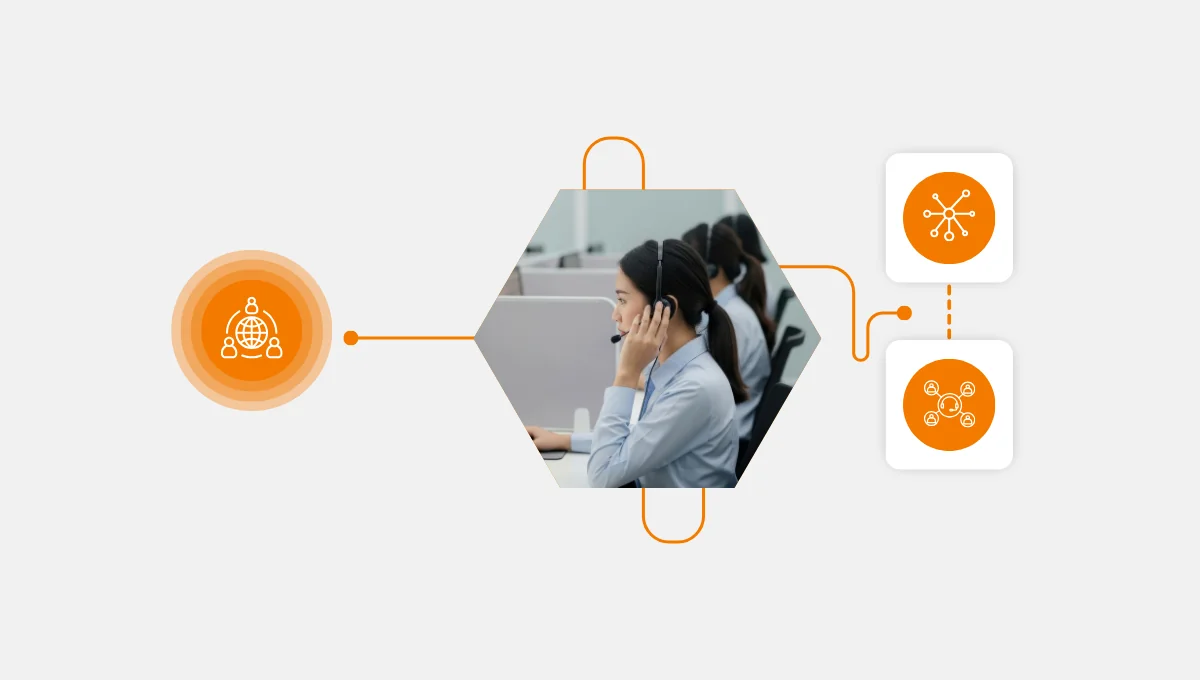Call center peak seasons can be brutal on morale, performance, and retention. If you see the following signs in your team:
- Sudden dip in talk time, CSAT, or adherence
- Increased absenteeism
- Snappy tone or silence on team chats
- “I’m fine” answers from previously talkative team members
Then it means you have to act immediately.
We’ve prepared a structured action plan and survey framework. This guide focuses on:
- Agent burnout prevention,
- Peak season support, and
- Practical ways to improve call center agent well-being.
Let’s lower the fever.
First Steps and Immediate Actions
In the thick of peak season chaos, the first few days can make or break your team’s mental stamina. Think of this as stress management in contact centers 101.
Acknowledge It Openly
Say the quiet part out loud: Let your agents know you see how hard they’re working. A short team huddle or message like:
“I know this season is intense. I appreciate you showing up every day. Let’s talk about how we can get through it together.”
Microbreaks & Flex Time
- Allow 5-minute mental breaks after tough calls.
- If possible, offer flexible shifts, half-days, or rotating time-off (even just an extra hour).
Shift Low-Value Tasks
- Temporarily pause non-critical admin work (reporting, manual tagging, long post-call notes).
- Use simple automations or AI tools to reduce load (chat summaries, suggested replies, etc.).
Give Fast Wins
- Offer small incentives: lunch delivery, coffee vouchers, a day off raffle.
- Gamify call performance (if done positively): “Most empathetic call,” “Best save,” etc.

Short-Term Strategy for the Next 2–4 Weeks
Once you’ve taken quick action, it’s time to look ahead just a bit. These next few weeks are critical and play a vital role in workforce management and help reduce agent fatigue before it becomes attrition.
Daily Check-Ins (5 mins)
- Not performance-related. Just: “How are you feeling on a scale of 1–10?”
- Use this to spot early burnout signs or rising stars who need encouragement.
Mental Health Touchpoints
- If you have access to EAP (employee assistance programs), make them visible and normal to use.
- Bring in a guest coach or mental health pro for a quick optional session on coping skills.
Pair Up Agents
- Create a buddy system so people feel less alone.
- Newer agents especially benefit from a peer who’s “been there.”

Longer-Term Actions: Culture Changes
If peak season support feels like a recurring storm, it might be time to invest in better infrastructure. Incorporating employee engagement practices and sustainable contact center scheduling are key here.
Train Leaders to Spot Burnout
- Supervisors should be trained to see changes in tone, pacing, missed breaks, not just metrics.
Rotate Roles
- Offer agents different responsibilities: onboarding new hires, testing a new script, QA reviews, something to break monotony.
Run a quick anonymous survey:
- What’s draining you most?
- What would help?
- What do you need from me right now?
CCS-Specific Burnout Action Plan for Managers
Call Center Studio features offer powerful tools to help you proactively manage agent stress and balance workloads more intelligently.
Use Real-Time Dashboards to Spot Overload
Go beyond handle time and look for:
- Sharp dips in Average Talk Time or Wrap-Up Time
- Spikes in After-Call Work (ACW)
- Agents in the “red zone” can be rotated out of live queues briefly for recovery.
Use IVR + AI call routing to send easier calls to junior or less-burned agents.
- Save complex/emotional calls for senior agents only when necessary.
- Enable priority-based routing to reduce queue stress.
Broadcast Motivational Messages
Use Internal Announcements to:
- Share thank-yous from leadership
- Highlight top performers (not just metrics-based)
- Share self-care tips
Create Smart Shifts
- Use Smart Scheduling to rotate breaks more equitably.
- Offer micro-shifts (3–4 hours) for high performers with fatigue.
These flexible staffing strategies and Call Center Studio features help reduce agent fatigue and improve operational efficiency.
What You Can Automate Now
| Area | Feature | Benefit |
| Call Triage | AI Bot / Voice Bot | Handles routine queries to free up agents |
| Agent Support | Real-Time Script Suggestions | Reduces pressure in live calls |
| ACW Time | Auto Summary & Tagging | Gives agents breathing room |
| Queue Stress | Smart Routing & IVR | Keeps complex calls from overwhelming everyone |
| Recognition | Internal Broadcasts | Boosts morale & team culture |
Bonus: Internal Burnout Pulse Survey
This quick survey gives you a snapshot of burnout risks and morale. Keep it simple, anonymous, and actionable.
Title: How Are You Feeling This Season?
Estimated Time: 2–3 minutes
Purpose: To check in on how you’re doing and where we can support better.
Section 1: Quick Check-In (1–5 Scale)
(1 = Not at all, 5 = Very much)
- I feel physically and mentally drained after my shifts.
- I feel supported by my manager/team leads.
- I’m managing my workload comfortably.
- I feel like I have enough time to take proper breaks.
- I still feel motivated to show up and do my best.
Section 2: What’s Making Things Harder?
(Check all that apply)
- Long queue times
- Difficult callers
- Not enough breaks
- Repetitive tasks
- Pressure to meet KPIs
- Not feeling heard
- Lack of variety or growth
- Other: _________
Section 3: What Would Help Right Now?
(Choose up to 3)
- Shorter shifts
- More breaks or flexible break times
- Temporary shift in responsibilities (QA, training, etc.)
- More encouragement from managers
- Better tools or automation for routine tasks
- Recognition or shout-outs
- Talking to someone privately
- Other: __________
Section 4: Anything You’d Like to Say?
(Optional open text)
Your message is anonymous, but we read every word.
Summary
Call center peak seasons can take a serious toll on your agents’ mental health and productivity. Follow our practical, actionable guideline for agent burnout prevention, and boosting contact center productivity.
And do not forget to book your Call Center Studio DEMO to automate the grunt work and reduce stress.





